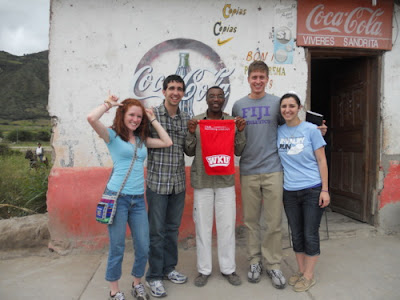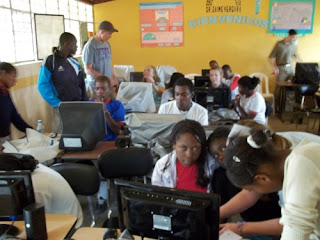Monthly Archives: June 2011
Day 6 – Una Minga
 We’ll be making our third and final trip to Santa Ana Sunday to present them with the computers that we brought with us. The training has taken place in nearby Concepcion because the furniture company wasn’t able to deliver the proper equipment to hold the lessons in Santa Ana. However, next week, after we have returned to Quito, the town will be able to fully install the computers that the city of Bowling Green donated and Gene Iglehart programmed for them.
We’ll be making our third and final trip to Santa Ana Sunday to present them with the computers that we brought with us. The training has taken place in nearby Concepcion because the furniture company wasn’t able to deliver the proper equipment to hold the lessons in Santa Ana. However, next week, after we have returned to Quito, the town will be able to fully install the computers that the city of Bowling Green donated and Gene Iglehart programmed for them.As for me, I had one of the most humbling days of my life.
 |
| before |
 |
| after |
 |
| Wade Haga |
 |
| trago de caña, Ecuadorian moonshine |
Hand in hand, the men of Santa Ana and our team for the park project worked to erect this park that had existed in only our minds for months. There is an old word that dates back to ancient Andean culture for this called una minga. It means community work. My favorite interaction is when one of the local men offered us some trago de caña, otherwise known as moonshine, to speed the process along. As we hammered nails and screwed in screws, I couldn’t believe how tangible our dream had become. All the nights spent worrying about failure and all the scrapped plans seemed so distant as the kids started jumping on the columpios (swings) and resbaladeras (slides). It was impossible to believe this started as an idea to smuggle pieces of wood in our suitcases to build a couple of benches.
 Before we left, one of the men thanked us for coming and partnering with them. He told me that it meant so much to Santa Ana to have this opportunity. He closed by saying, “Siempre, las puertas de Santa Ana están abiertas a ustedes.” (Always, the doors of Santa Ana are open to you all.)
Before we left, one of the men thanked us for coming and partnering with them. He told me that it meant so much to Santa Ana to have this opportunity. He closed by saying, “Siempre, las puertas de Santa Ana están abiertas a ustedes.” (Always, the doors of Santa Ana are open to you all.)
He has no idea how thankful I am for the opportunity to help, though it didn’t stop me from trying to explain.
Ojalá que la gente de Santa Ana disfrutare este parque por siempre. [God willing, they will enjoy this park forever.]
Day 5 – Santa Ana: Projects Kick-off
|
“The computers were slow, so people were on different parts of the lesson,” he said. “Gmail thought we were running some sort of pyramid scheme, so we had to call to verify the accounts but didn’t have phones. The computers were programmed differently, and we didn’t get everything done the way we wanted.”
“But we know what to do for tomorrow’s lesson. We worked well today despite the problems. We learned how to adapt, and everyone was helping. We did really good considering all the problems.”
|
Even with the rough patches, Kyla Gwyn, a student at MTSU, said the day was a definite success for the weekend on the whole.
“We built relationships that will help us more than anything tomorrow. I know I got a lot more accomplished today towards the end when the people started feeling more comfortable with me, and I got to know them. We have two days, so really, today turned out great.”
 My group went to locate a specific place to build the playground set we ordered from Technoswiss tomorrow. We went alone with no interpreter, so my Spanish skills quickly sharpened as I met community leaders willing to help and conversed with the local kids in Santa Ana’s elementary school to get them excited about their new playground. Many of us played soccer or climbed on whatever we could find with them.
My group went to locate a specific place to build the playground set we ordered from Technoswiss tomorrow. We went alone with no interpreter, so my Spanish skills quickly sharpened as I met community leaders willing to help and conversed with the local kids in Santa Ana’s elementary school to get them excited about their new playground. Many of us played soccer or climbed on whatever we could find with them.Day 4 – Otavalo: Bread and Roses
 First and foremost, this bread was amazing. It was super buttery and warm, and we had it with some with a type of cheese called queso de hoja. Era sabroso. (It was delicious!)
First and foremost, this bread was amazing. It was super buttery and warm, and we had it with some with a type of cheese called queso de hoja. Era sabroso. (It was delicious!)
 |
| tour guide and rose farmer (left) |
We kept travelling north from the rose farm to Otavalo. On our way, we stopped in a small town called Pijal. We learned loads about traditional Ecuadorian herbal medicine from our tour guide there . She also shared with us a huge meal and the story of her cousin that was taken to Australia because her lack of education left her vulnerable. Unable to read, she struggled to escape the control of the woman that had taken her there from Quito. Finally, in a manner only capable by God to our guide, a woman freed her and took her to the United States and has taught her how to read. Now she is a very happy and visits Ecuador from time to time. Our guide looks at her cousin’s story as a source of inspiration and treated us to a dinner in her house to demonstrate her ambition to employ the people in Pijal . She makes complex embroideries and enjoys her work very much.
Day – 3 Playground Planning
 |
| Margarita Columba |
A special thanks must also go out to the Alive Center at WKU. We could not have done this project without your grant and help.
Day – 2 Exploring Quito
 Since I talked about it in the last post, I figured it would be best to start off with a picture that includes the backdrop of the city. I’m not sure the picture illustrates it as well as I’d like, but the city really does swim through the Andes mountains. It’s truly a sight to behold with all the buildings sprawling out like a rushing river through the valley. It also helps to see it from the top of a monestary roof here in Quito It may have been a bit dangerous climbing up there, but the view was worth it
Since I talked about it in the last post, I figured it would be best to start off with a picture that includes the backdrop of the city. I’m not sure the picture illustrates it as well as I’d like, but the city really does swim through the Andes mountains. It’s truly a sight to behold with all the buildings sprawling out like a rushing river through the valley. It also helps to see it from the top of a monestary roof here in Quito It may have been a bit dangerous climbing up there, but the view was worth it We did all of this as part of a tour of the historical part of Quito. It has such a rich history that our tour guide, Patricia, shared with us. She was the one that got us behind the scenes and on top of various roofs in Quito. The views were always amazing and the amazing amount of cultura (culture) never ceases to overwhelm me. I did manage to grasp a bit of it though as we visited a boutique that sold Panama hats. You may be wondering why Ecuador is selling Panama hats… It’s actually because those hats originated in Ecuador but were shipped out through Panama, thus giving them their misinformed name.
We did all of this as part of a tour of the historical part of Quito. It has such a rich history that our tour guide, Patricia, shared with us. She was the one that got us behind the scenes and on top of various roofs in Quito. The views were always amazing and the amazing amount of cultura (culture) never ceases to overwhelm me. I did manage to grasp a bit of it though as we visited a boutique that sold Panama hats. You may be wondering why Ecuador is selling Panama hats… It’s actually because those hats originated in Ecuador but were shipped out through Panama, thus giving them their misinformed name.














